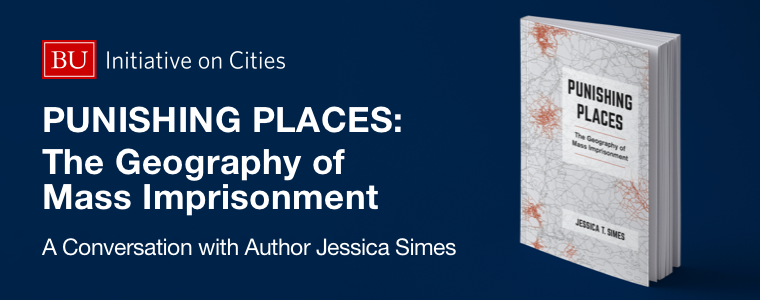Punishing Places: The Geography of Mass Imprisonment
Held on Wednesday, November 17, 2021.
Watch a full recording of the event, or scroll down to read a recap and watch event highlights.
Recap by Amelia Murray-Cooper
On Wednesday, November 17, 2021, the Boston University Initiative on Cities (IOC) hosted a conversation with Jessica Simes, Assistant Professor of Sociology in the BU College of Arts and Sciences regarding her new book, Punishing Places: The Geography of Mass Imprisonment. Speaking with IOC Co-Director Katharine Lusk, Simes discussed the consequences of mass incarceration in the United States, particularly in smaller cities, suburbs, and rural areas. In Punishing Places, Simes analyzed the community-level effects of prisons and shared urgent policy reform implications.
In some communities, millions of dollars of state expenditure are spent on prisons. “It forces you to think about if we applied the funds in the civic infrastructure to education or healthcare or social welfare, how we might transform social inequality in cities,” said Simes. She also described incarceration as a violent and harmful experience where people face material deprivation and dehumanizing conditions.
Simes analyzed a unique dataset regarding the last addresses people lived in prior to facing incarceration in Massachusetts. She explained that many prisons do not collect this data, and researchers often estimate information based on where people were convicted by a court, which may differ from where they lived. Accessing this data allowed Simes to remove assumptions about where people were coming from, relying instead on data.
Massachusetts has the lowest rate of incarceration in the United States, but it has a rate two to three times higher than other liberal democracies like France, Germany, and Scandinavia. Although Simes planned to examine large cities like Boston, she found that the spatial pattern in Massachusetts and across the country had changed in recent decades. Today, smaller cities, suburbs, and rural areas have the highest rates of incarceration. These areas are referred to as “forgotten cities,” or places that are not considered important for urban planning and sociology. They are also characterized by untamed opioid epidemics and large distances from job centers, which further contribute to the cycle of incarceration.
Simes described her work as contextual and spatial. Contextually, she studied the conditions that make communities more vulnerable to policing and punishment, such as racial segregation, deep poverty, and high rates of drug arrest. Spatially, she examined how the scale and diffusion of these issues across boundaries have allowed mass incarceration to become prevalent in areas where it did not previously in the 1980s.
Simes spoke with people across Massachusetts involved in organizations that support reentry after incarceration, including housing, mental illness, and substance abuse services. Many people said the state focuses its resources on Boston and gives little support to smaller cities like Worcester, despite it being the second largest city in New England. For example, a Massachusetts town was informed they could not have a housing shelter because there was already one located in Springfield, but there was no public transportation between the communities. People also reported seeking residential treatment or medication-assisted treatment outside the state because of a lack of local resources.
Further, Simes found that laws are not applied uniformly across the state. In large cities like Boston, reform efforts have led to changes in policing practices and more progressive prosecutors. Suburban and rural areas often have harsher sentencing, particularly for drug-related offenses. This causes higher rates of community loss, which is a measure of how many years people are sentenced away from their community. Simes explained, “We can say we have a normative commitment to full membership in our society. We can measure that by seeing if people are here, or if they’re not here. Are they able to participate in politics and the labor force, or not?” Simes said.
While these spatial trends are significant, racial disparity is still the fundamental indicator of incarceration. Simes analyzed how many people from specific racial groups were incarcerated rather than present in their communities based on national data from over 3,000 counties. She discovered that there were 3, 80, and 1,200 counties where White, Latino, and Black populations were at least two times more likely to be represented in prison populations, respectively.
Simes also discussed the responsibility of the government to prevent arrests. She drew a comparison between incarceration and lynching, which is a historical example of racial violence that enrages people today. “I wonder if we can get to a place as a society where we think about contact with the police in similar ways, where it represents a rupture in our society, one that allows people to live freely and be safe,” Simes said.
Simes explained that local change is needed, but federal influence can also be impactful. For example, Ferguson was a powerful case that became one of the few suburban police departments to be investigated by the Department of Justice. Broadly, Simes explained that society can be restructured to render the prison as having the smallest possible footprint. She pointed to a reparative justice system that quantifies how communities have been harmed by this loss. When a state systematically harms its citizens, reparative justice is a model that includes an apology, a promise of non-repetition, compensation, and rehabilitation for the harm.
These solutions require a commitment to significantly reducing incarceration rates today, as well as considering the intergenerational effects of the system. “We have to start questioning, what is the prison system serving in our society?” said Simes. “It goes so far beyond incarcerating people on the basis of crime alone.”
This event was part of a series on Race, Place, and Space, co-hosted by the IOC, the BU Arts Initiative, and BU Diversity & Inclusion (D&I). The series explores the ways in which racial and ethnic groups access, inhabit, occupy, shape, and are memorialized in urban contexts—as well as the ways their contemporary and historical contributions have been made invisible, disregarded, or denigrated.
